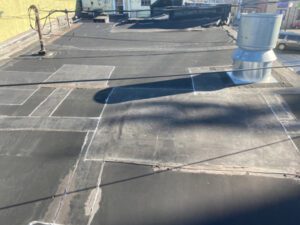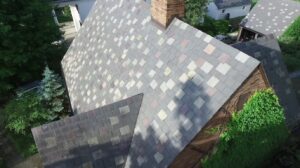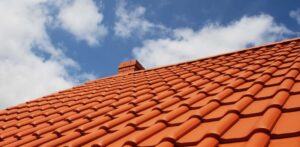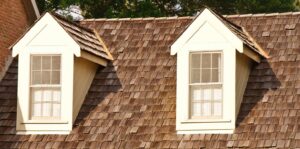Many buildings, particularly commercial structures, employ flat or low-slope roofs that are typically comprised of rubber, PVC, TPO, or on older buildings, classic “built-up” roofing systems. They were typically designed to have low slope roofs to eliminate “wasted” or unusable space required for higher roof slopes. For example, consider the shape and vertical space of a grocery store to a classic church. The church typically has high, vaulted ceilings, while the grocery store has no wasted vertical space and can store goods virtually to the ceiling. This results in the grocery store looking like a “box” and the church, with its steep slope, more resembling and upside down “v”.

The Impact of Roof Slope on Water Shedding
From a roofing point of view, these are drastically different scenarios, as the high sloped church roof sheds water incredibly fast, while the grocery store roof must hold and effectively drain off the water, albeit at a much slower speed. Over time, low-slope roofs will develop leaks, from open seams, punctures, failing sealants, clogged drainage, wildlife damage, UV shrinkage, and other environmental factors. Since the water sheds much slower on a flat roof that a pitched one, any deficiency will leak more severely than a pitched roof, while requiring more maintenance and repair.
The Advantages of Converting to a Sloped Metal Roof
However, there are options to convert a flat or low slope roof to a higher pitched metal roof, greatly increasing both the water shed rate and durability of the roof. A pitched standing seam metal roof, with no exposed fasteners, offers far greater puncture resistance, has no seams, drains into traditional gutters and downspouts, is fireproof, and offers maximum protection and wind and hail, when compared to single-ply low-slope roofing. Metal roofing requires virtually no maintenance, which is another cost expense on low-slope roofs.

The steps to convert a low-slope roof to a pitched standing seam roof involve the following steps:
- Analyze and prepare the existing roof structure – The underlying structure beneath the low-slope roof must be evaluated to ensure it is not rotted or deteriorated and can hold the additional weight of the metal structure. While metal roofing does not add a tremendous amount of additional weight, it is important to ensure the decking and support structures are in good condition prior to starting the project.
- Add slope to the flat roof – The slope conversion process is achieved by installing a sub-framing system over the low-slope area, that builds in slope and helps distribute the weight of the new metal roof over the entire structure. This also provides a clean and ready-made surface to install the new standing seam roof upon.
- Install a metal standing seam roof – A standing seam metal roof is installed in such a way that there are no exposed fasteners in the roof, eliminating potential leak points. In addition, the panels are run in a special machine to the full length of the roof section, leaving no seams in the roof as well. This roofing system has few potential leak areas, when compared to the myriad of seams, flashings, and penetrations in a low-slope system.
How Does Slope Conversion Make “Cents”?
While a metal standing seam roof is more expensive than installing another low-slope membrane, the long-term cost savings add to be significant over time. Every major manufacturer of low-slope roofing requires annual maintenance inspections, which void the warranty if not performed. These roofs are easily punctured, causing leaks, that can be costly in both interior damage and on-roof repair. In order to account for expansion and contraction due to heat, sealant joints are used that must be re-applied every 3 to 5 years. The interior drains need to be kept clear and free of debris to prevent water ponding on the roof. The costs and upkeep required on these systems are substantial in order to get the expected service life out of the low-slope roof.
In contrast, the costs of a metal roof are typically all up front, in adding in the slope and installing the new roof. Standing seam roofs require little to no maintenance, as they have no seams and don’t rely on sealant joints for attachment. Drainage is typically to traditional gutters and downspouts, which can be covered to prevent debris buildup. Finally, with a service life of 50 years or more, almost twice the length of a low-slope roof, a metal roof lasts longer, with less costs, leaks, and required maintenance. This leads to significant savings over time!





